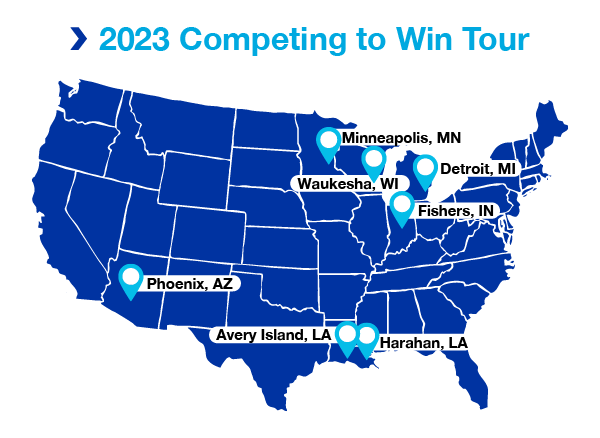Cornerstone Building Brands’ Rose Lee on Leadership in Manufacturing
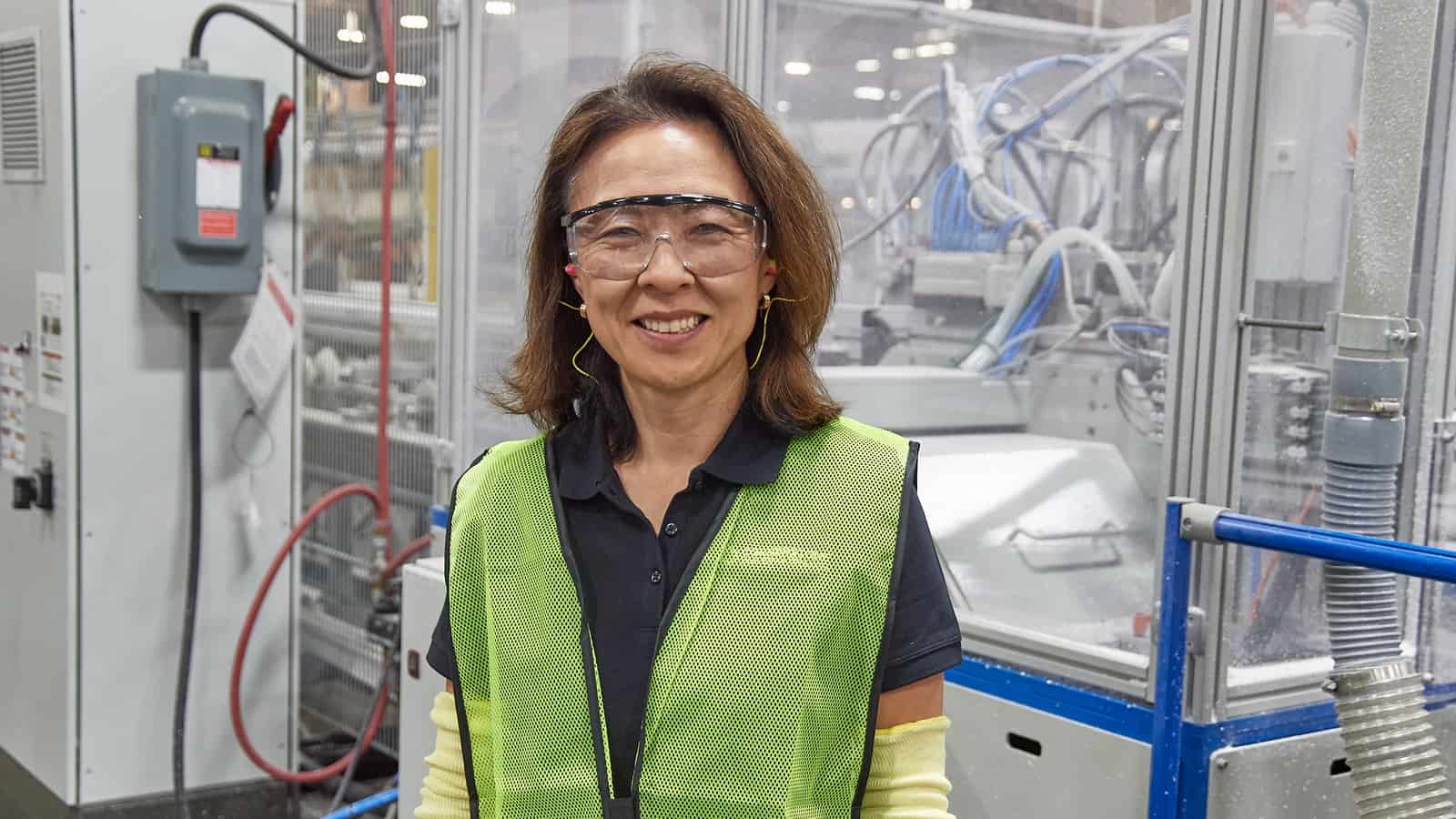
“It is up to us to shape our future,” Rose Lee advises women in manufacturing.
Women should “take the opportunity to lead and do it in your own way with the outcomes you know you’ll be able to produce so others will see you as an example of diversity,” continued the President and CEO of North Carolina–based Cornerstone Building Brands and member of the NAM Executive Committee. “There is not just one way of doing it, even in the manufacturing environment.”
This year, Lee is serving as chair of the Manufacturing Institute’s Women MAKE Awards, which will honor more than 100 outstanding women working in the industry. We spoke to Lee ahead of the awards ceremony, and here’s what she had to say.
Finding your passion: Lee describes herself as someone who derives a lot of satisfaction from the work she does—and wants to ensure others can do the same.
- “In our company, we are part of creating things that are part of the most important things in your life: your home, your shelter,” said Lee, who holds degrees in aeronautical and mechanical engineering as well as an M.B.A. “I find that very meaningful.”
- But her focus extends beyond the tangible, too. “There’s the content of what is done, but then there’s the opportunity that can be created for others … [which] increases the probability that they can find passion and enjoyment … like I had the opportunity to do.”
Increasing diversity: When it comes to diversifying the job pipeline in manufacturing, candidates themselves can often play a bigger role in their own success than they may realize, Lee said.
- “It starts with awareness that there are these opportunities. Then, [candidates should seek] the training, exposure and knowledge that are critical for these roles.”
- Meanwhile, “those of us who have the opportunity [must] make our voices louder,” she added. “Reach out to help people understand more clearly what is required and how you can advance yourself.”
- “We should all think about what more we can do ourselves and what more we can do together to welcome more women into manufacturing.” she continued.
Workplace flexibility: The same goes for manufacturers seeking to increase the number of women in their workforce, Lee added.
- “There is no magic solution,” Lee said. “But it’s important for companies and organizations to have a supportive structure, whether by providing [varied] job content, time off or additional flexibility in the work environment that [allows women to] balance things better.”
- “Supporting great initiatives that prioritize recognition, mentoring, education, skills training and networking are powerful ways to build a much stronger pipeline of women in manufacturing.”
Letting it go: Lee also knows a lot about having a rewarding career in manufacturing while being a caregiver at home—because she’s learned it firsthand.
- “Just remember that you can’t be everything to everybody all the time,” said Lee, a mother of two daughters. “It’s OK; let it go. Your kid doesn’t have to look like they’re in their Sunday best all the time.”
- Nor does the parenting style or career path that works for someone else have to work for you, she added. “You’ve got to design [being a working parent] so it’s bespoke to your life.”
Making history: Last year, when Honeywell International added her to its board of directors, Lee became the first Korean American woman to sit on the board of a Fortune 100 company. She regards the position as an opportunity to accomplish even more.
- “The building materials space doesn’t live in isolation,” Lee said. “Having a connection to a broader space, under global dynamics, helps [create] connectivity. We are continually deepening our knowledge.”
How Manufacturers Can Recruit Effectively

With 9.9 million job openings in the economy and 5.7 million people looking for jobs, the labor market is tight, with only 58 job seekers for every 100 job openings. Manufacturers who are looking to fill almost 700,000 jobs are struggling to find talent. That’s why the Manufacturing Institute convened a group of manufacturers last month for the Solution Series: Recruitment Workshop, where they discussed recruitment challenges and identified ways to address them. Here are some of the takeaways.
A wide range of challenges: At the beginning of the workshop, participants brought up the challenges they face in recruiting employees, particularly hourly and shop-floor workers.
- The most commonly cited challenge was communicating company culture and brand messaging. Several manufacturers in attendance had multiple locations with different cultures, which made it difficult to create consistent job postings. Meanwhile, other companies did not have a defined mission or set of values that they could easily promote to prospective employees.
- As one participant put it, “It’s important to think through why working at your company is good. This is different than the reasons why buying from the company is good.”
- Other challenges that participants shared included determining the right compensation in a competitive labor market, educating upper management on the changing economic landscape and attracting a wide array of candidates.
Food for thought: Participants then listened to industry experts speak about manufacturing employment trends, fair chance hiring, the gig economy and the importance of speed in recruitment.
- Employment trends: Manufacturers are competing against other manufacturers and industries for the same, limited labor pool, noted Chad Moutray, the director of the MI’s Center for Manufacturing Research and the NAM’s chief economist. “Issues like company culture, flexibility and career advancement become critical differentiators in a tight labor market,” he advised.
- Fair chance hiring: As Cassi Zumbiel, managing director at Envoy, put it, “Many of the barriers keeping second chance workers [individuals with criminal records] from good jobs were instituted by employers when the labor market was dramatically different, when there was a surplus of labor. That’s not the case anymore. Fair chance hiring can help address the labor shortage.”
- Gig workers: Wes Wood, director of strategic growth at Veryable, shared how his company’s online application connects gig workers to manufacturing jobs, filling in gaps in second and third shifts and having a positive impact on company culture.
- Recruitment: With manufacturers facing stiff competition for talent, moving quickly in the recruitment process makes a difference. Mike Schaefer, senior vice president at FactoryFix, described how his company supports manufacturers by automating follow-up within 15 minutes of a job seeker submitting an application.
Time to brainstorm: Participants also broke out into small groups to discuss their top challenges and brainstorm solutions. Here were some of their recommendations:
- Tighten up the job description. Think of a job description as an advertisement—not a contract. Keep it short. As one participant put it, “You don’t want to advertise accountability.” Another good tip: An external job description should not be the same as the internal job description. Only the latter should include all the details and technicalities.
- Streamline the application process. Don’t require a resume or cover letter for most of your hourly or entry-level positions. Ask only the key questions and reserve more in-depth ones for the phone screen or interview. One company cut its process down from 12 minutes to 3—and started receiving significantly more applications.
- Think about how to source talent. Consider working with K–12 schools, vocational programs and community colleges, or consider creating a second chance program, veterans program or refugee program. Lots of great talent pools exist. Manufacturers should explore their local options, find community partners and conduct consistent outreach.
The last word: After a day of energizing conversations, participants left ready to implement what they had learned. As one attendee put it, “Hearing what works and doesn’t work for other manufacturers was absolutely amazing.”
A FAME Student Finds His Place at Electrolux Group
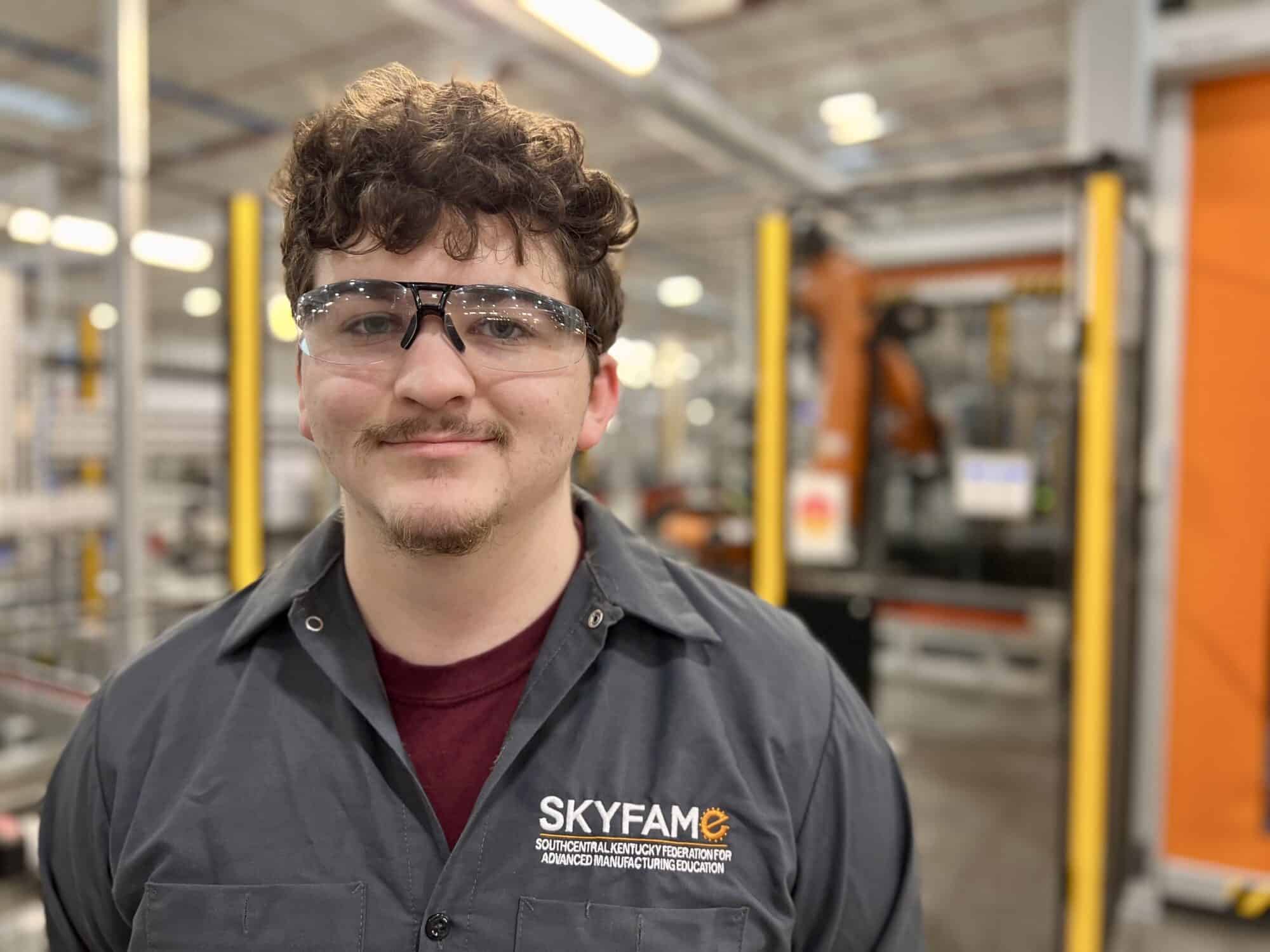
From the first moment Caleb Cleveland visited Electrolux Group—a home products and appliance manufacturer in Springfield, Tennessee—he knew it was the place for him.
“I knew I wanted to work with my hands,” said Cleveland. “I didn’t want to be sitting at a desk in front of a computer screen. I loved this place from day one.”
Cleveland found Electrolux Group through the Federation for Advanced Manufacturing Education program, or FAME, which his guidance counselor recommended to him. Today, both he and his employer are thrilled he’s taking part.
The program: Founded in 2010 by Toyota and operated today by The Manufacturing Institute, FAME aims to help students become highly skilled, sought-after workers capable of meeting the unique needs and challenges of the modern manufacturing sector.
- It provides current and aspiring workers with on-the-job training and classroom education, leading to an associate degree and the FAME advanced manufacturing technician certificate.
- “This program is one of a kind,” said Cleveland. “I’m actually getting paid to go to school. I’m getting the classroom and training classes here at Electrolux Group. I’m learning from people at school and from experts here.”
The benefits: At a time when manufacturers are struggling with record high job openings and a lack of skilled workers, FAME is helping to bring in a new generation of employees.
- Cleveland will be the Electrolux Group’s first graduate of the program when he completes it in May 2024, and the company sees his success as both a point of pride and an investment in the future of manufacturing.
- “We are committed to continuous upskilling of our current workforce and this is a strong pipeline for new talent with digital skills,” said Electrolux Group Senior Manager of Learning Dan Caldwell. “Part of our strategy is to partner with the FAME program so we can not only bring in Caleb with his classroom knowledge, but also help him to learn and grow.”
Changing minds: FAME is also helping to improve perceptions of the manufacturing industry among young people.
- “In the past, manufacturing has had a dark and gloomy reputation, and we are changing that perspective,” said Electrolux Technical Trainer Eric Drake. “We want up-and-coming talent to know that there are people in manufacturing who care about their future and want them to succeed. We’ll provide the stepping stones for their journey.”
Off to a great start: According to Caldwell and Drake, Cleveland has been an enormous asset for the company already.
- By the end of his first semester, he was able to step in and do most of the work of a process technician, filling in at a time when the company was shorthanded.
- “Caleb is doing a knockout job,” said Drake. “Our objective is to make opportunities available for him.” Caldwell added, “We are incredibly proud of Caleb with the initiative he takes.”
The bottom line: “The program has exceeded my expectations,” said Cleveland. “When I first started I was worried about being seen as that intern who sticks to somebody’s hip. But at Electrolux Group, I found my own place.”
A GM Engineer Follows in Her Parents’ Footsteps
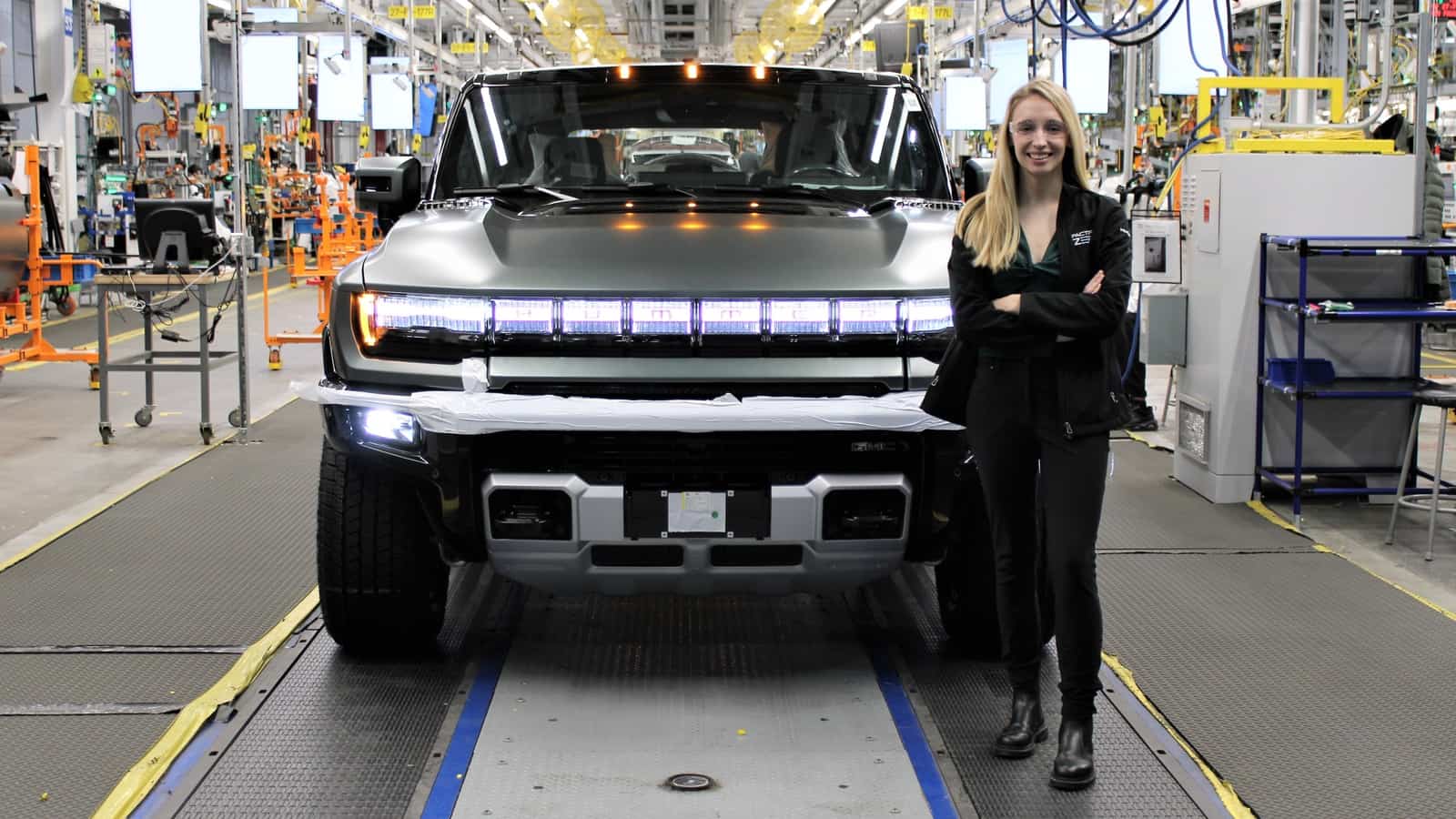
Alison Holland was almost predestined to be an engineer at General Motors. Born to an electrical engineer mother and a mechanical engineer father, both of whom work at GM, she grew up entirely familiar with the discipline and the company.
Today, she’s working to establish GM’s first-ever assembly operations for a new EV battery platform at Factory ZERO in Detroit-Hamtramck, Michigan. Recently named an Emerging Leader by the Manufacturing Institute’s 2023 Women MAKE Awards, which honor outstanding women in the industry, Holland spoke to us about her career, her work helping other young women find their footing and her goals for the future.
Not your mother’s industry: As the daughter of a female engineer, Holland has a unique perspective on the role of women in the industry. How was her mother’s experience different from her own?
- Women were much more in the minority back then, Holland said, and her mother “had to work even harder to earn her way to the top.”
- Holland learned a great deal about managing her own career from her mother, a kind, patient parent who never missed her four children’s activities or let the pressures of work invade her home life.
Choosing manufacturing: While her parents’ example set her on the path toward manufacturing, Holland also attributes her comfort in the industry to her competitive nature.
- The former college soccer player says manufacturing has a similar feel to sports and is rewarding for those who want to excel in a “high-paced” environment.
- “I wanted a career where I could be challenged and see my efforts pay off with real-time results”—just as she did on the field.
A sustainable career: At GM, Holland is part of an exciting project: launching GM’s first battery assembly plant under the same roof as EV truck assembly at Factory ZERO. The battery, or Rechargeable Energy Storage System, is based on GM’s Ultium battery platform, which will increase the range, power and performance of a number of different vehicle types. She works with coordinators and engineers at different sites, making sure best practices are codified and shared throughout the company.
- Holland loves her work because “it’s a new challenge every day. I’m helping to reinvent the wheel when it comes to battery production. The small decisions we make will have a long-lasting impact.”
A young leader: Holland considers herself lucky to have had excellent female mentors, who helped her learn to “make her opinions heard.” Today, she helps other people, including many women, find support for their own goals.
- As part of GM’s early career development program for manufacturing engineers, Holland organized events like lunch-and-learns so that young workers could hone their professional skills together and build productive relationships. She also helped participants find and benefit from mentors who previously went through the program.
- Holland also provides coaching to women who are experiencing professional “firsts”—such as the first time they work on the production line, or encounter a new process, or lead teammates with unique backgrounds. Holland began this work while serving as a mentor in the early career development program and has kept it up as she leads her own team.
What’s next? When Holland looks ahead, all she sees are opportunities. “I am super interested in sustainability. I want more experience in other production departments, so I can understand all the other sides of the business. I want to have more cross-functional experiences, so I can better understand what people are asking of me.”
The last word: Holland has simple but important advice for young women starting out in the industry. “Learn as much as you can. Take any opportunity to learn about the industry. That will boost your confidence. It takes some time and you’ll make some mistakes, but all of those experiences matter.”
A Young Engineer Makes Herself Heard in Manufacturing
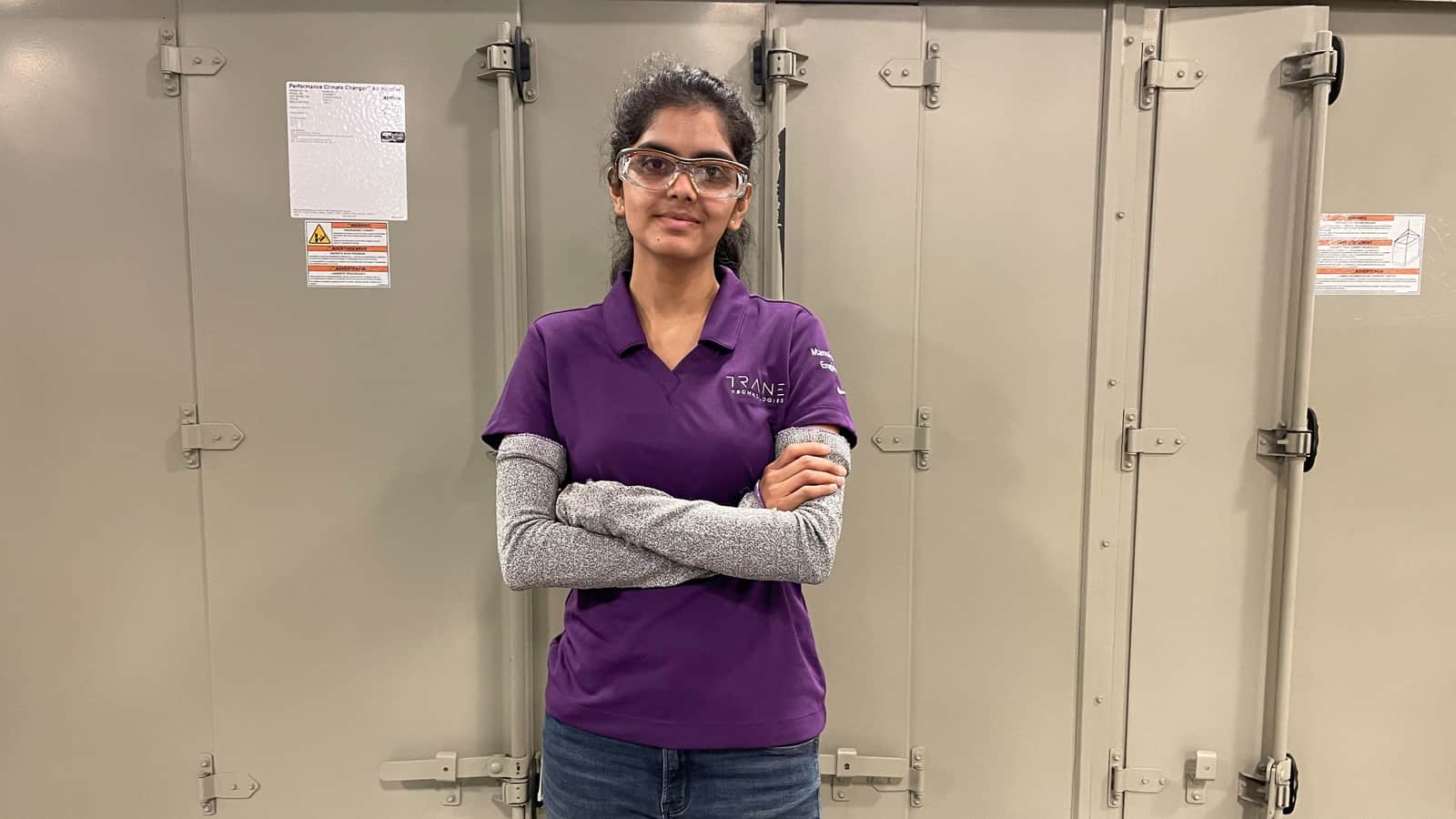
Rashmi Vadlakonda is a woman with a voice, and she’s not afraid to use it.
As a manufacturing engineer at Trane Technologies—a company focused on sustainable climate innovations—Vadlakonda is making advancements in engineering and paving the way for more women of color to join her. That’s why she was recently recognized by the Manufacturing Institute’s 2023 Women MAKE Awards as an Emerging Leader.
The award: The Women MAKE Awards, formerly known as the STEP Ahead Awards, honor top female talent in the industry while providing honorees with a platform to inspire other future industry leaders. Vadlakonda sees the honor as an opportunity to keep speaking up for people who are underrepresented.
- “I believe that for young women in manufacturing, especially for me as an immigrant young woman of color … a title helps,” said Vadlakonda. “This award gives me that title [and] the courage that I need to speak up and say, ‘Hey, I have something to share, and I want you to listen to me. There’s a reason I was recognized.’”
Starting out: Vadlakonda wasn’t immediately drawn to engineering, but when she was growing up in India, it was typical for young people to pursue engineering or medicine.
- Once she “fell into it,” she loved it, and took an especially strong interest in 3D printing while in graduate school at North Carolina State University. Her passion for 3D printing is what brought her to Trane Technologies.
Making the transition: When she first came to the company, she was responsible for operationalizing additive manufacturing throughout the company.
- She spent a few years in a corporate setting, traveling to different offices and introducing advanced manufacturing technologies—but when the pandemic hit and travel was largely suspended, she had plenty of time to think about what she wanted to do next. That’s when she decided to pivot to working in a factory setting.
- “The factory is a basic building block of the manufacturing industry,” said Vadlakonda. “Coming from a research background, I wanted to understand how a factory functions, how the people there think, how different groups interact with each other, and what it takes to actually deliver a good product.”
The factory floor: Vadlakonda is grateful she got a chance to work in both the corporate and factory environments. In a factory, she says, the pace is much faster, and you’re pushed to solve problems right in front of you. This was a challenge she found thrilling.
To women in the industry: When asked what her advice is for women in the industry, Vadlakonda first had advice for industry leaders. She believes they must create a comfortable environment for people from all walks of life.
- “Sure, you can get someone interested in manufacturing, you can help them come into the industry,” said Vadlakonda. “But we also have the responsibility of creating a welcoming environment where they feel like they can grow, so that they don’t leave, so that they’re happy here in the industry.”
The future: Vadlakonda, who is a champion of, and volunteer for, the industry’s Creators Wanted campaign to inspire the next generation of creators, believes it is vital that young people are exposed to manufacturing career options at an early age.
- “It doesn’t start with talking to women who have decided on a career path,” said Vadlakonda. “You have to start with kids. That’s why I like talking at Creators Wanted. Young people are naturally attracted to what they’re attracted to. Our job as adults is to help them see the options.”
The last word: “Manufacturing is very exciting,” said Vadlakonda. “It’s very interesting, you get to be creative and solve problems—and it’s such a satisfying feeling to solve problems.”
More Women Join the Manufacturing Workforce

Fresh off International Women’s Day, which was March 8, there’s some encouraging news on the labor front: more women are coming back to the workforce, both in manufacturing and throughout the economy.
In manufacturing: Female employment in the industry reached its height this year, with a total of 3.77 million workers, according to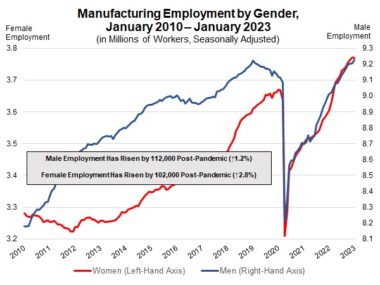 NAM calculations based on BLS numbers.
NAM calculations based on BLS numbers.
- Women now account for 29% of the manufacturing workforce.
- A year ago this week, the Manufacturing Institute, the NAM’s 501(c)3 workforce development and education partner, launched its 35×30 campaign, an initiative that aims to boost women’s share of the manufacturing workforce to 35% by 2030.
The overall economy: “Women have gained more jobs than men for four straight months, including in January’s hiring surge, pushing them to hold more than 49.8% of all nonfarm jobs,” according to The Wall Street Journal (subscription).
- “Female workers last edged higher than men on U.S. payrolls in late 2019, before the pandemic sent nearly 12 million women out of jobs, compared with 10 million men.”
Why it’s happening: The child-care disruptions and health concerns that made many women leave the workforce during the pandemic are diminishing, while employers offer historically high pay and increasing numbers of remote positions.
Why it’s important: More women in the workforce could help ease both worker shortages and inflation.
- With January unemployment reaching a 53-year low, “[a] greater supply of labor could work to counter rising wages and align with the Federal Reserve’s goal of cooling inflation,” according to the Journal.
- More job seekers could also help U.S. manufacturers, whose job openings edged up to 803,0000 in January.
The last word: “In just a year, the 35×30 campaign has made great strides in increasing the number of women in manufacturing—and the latest data show as much,” said MI President Carolyn Lee. “We’re close to our goal. Together, we can get the rest of the way there and make it to 35% by 2030.”
Professional Development Resource: Building Your Personal Brand
On February 16, the Manufacturing Institute held a professional development virtual event on building your personal brand, presented by branding expert Cat O’Shaughnessy Coffrin, Founder and CEO of CaptivatingCo.
View the recording here and the slide deck here.
TOPLINE TAKEAWAYS
Your personal brand consists of:
- Proposition: The value you create
- Persona: Your X factor
- Purpose: What drives you
Steps you can take to start building your personal brand:
- Self-Reflect: What role do you play on your team? What skills do you bring? Look for patterns in your career on how you approach your job and get things done.
- Ask For Feedback: Connect with your colleagues and friends and ask how they would describe the attributes, attitudes and skills you bring to the table. This external perspective is valuable for shaping your narrative.
- Connect and Reconnect: Remember that teacher who had a profound impact on you? Or a former colleague who you lost touch with? Reach out to them and schedule a coffee to catch up and remind yourself how many people are in your corner wanting you to succeed.
- Revisit Your LinkedIn: There are two simple step you can take right now to enhance your online presence; make sure your ‘About’ section is drafted in the first person (LinkedIn is a social platform!) and identify, follow and engage with leaders of topics that interest you.
Competing to Win Tour Visits INCOG BioPharma
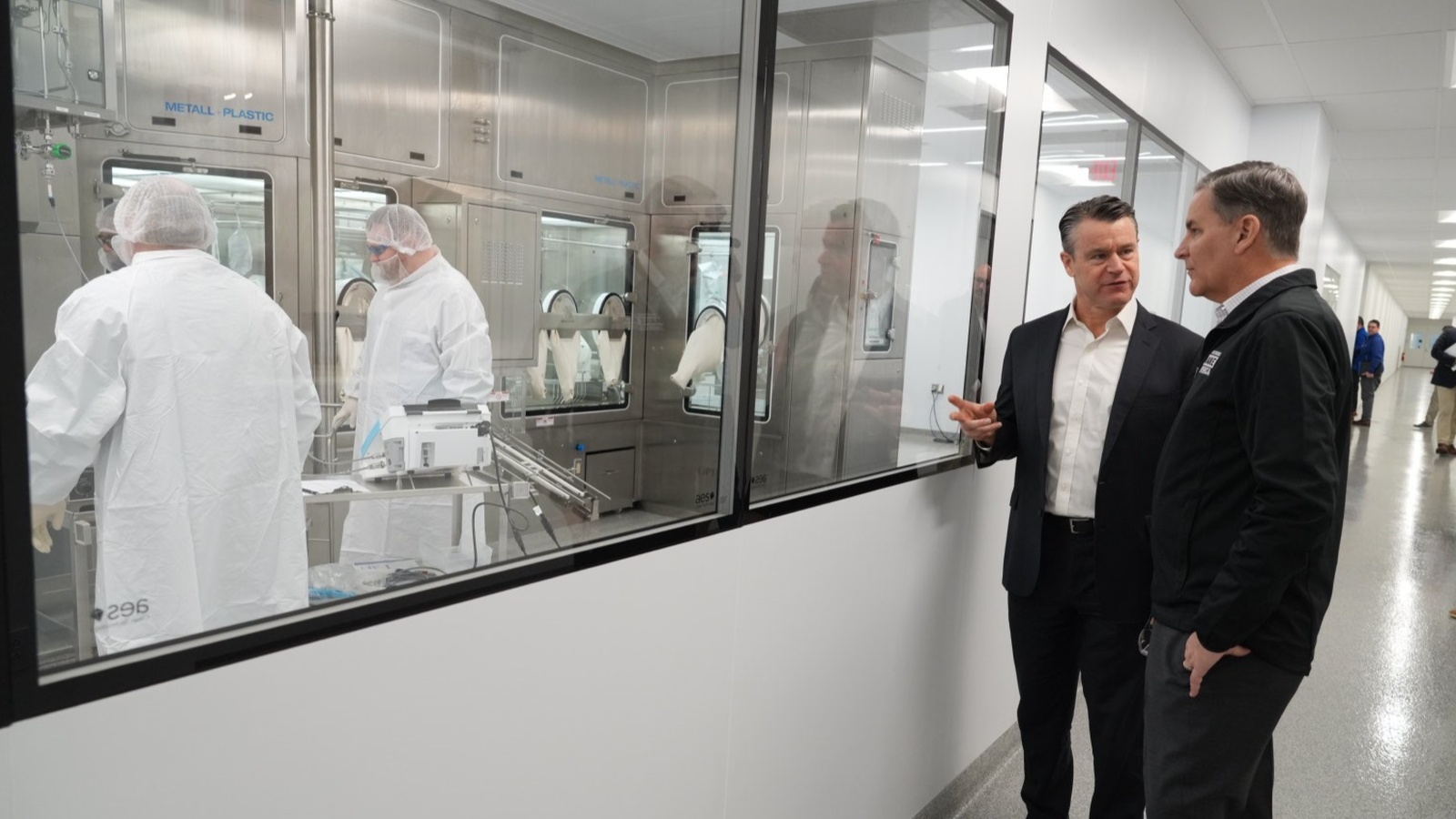
There’s no better way to see the power of manufacturing than by visiting a facility—which is why the NAM brought its Competing to Win Tour to INCOG BioPharma Services’ new state-of-the-art facility in Fishers, Indiana, yesterday.
A delegation including NAM President and CEO Jay Timmons, Sen. Todd Young (R-IN), Fishers Mayor Scott Fadness and INCOG BioPharma Services President and CEO Cory Lewis toured the company’s brand-new facility and discussed the importance of advanced manufacturing.
The tour: The NAM’s Competing to Win Tour is a nationwide event that highlights critical issues facing manufacturers in the United States.
- Designed to raise awareness around manufacturing opportunities—and foster conversation between local manufacturers, employees, media, community leaders and elected officials—the Competing to Win Tour kicked off this year with the NAM State of Manufacturing Address from Timmons at Husco’s headquarters in Waukesha, Wisconsin.
The host: INCOG knows firsthand about the challenges and opportunities in modern manufacturing. Founded in 2020, the company is a contract development and manufacturing organization that provides a wide range of pharmaceutical services, including drug development, clinical trial manufacturing and commercial manufacturing.
- In their new cutting-edge facility, which just opened last May, the company is creating sterile injectables and assembling devices to help their customers bring new drug products to market.
The panel: As part of the event, Timmons moderated a conversation between Sen. Young, Mayor Fadness and Lewis on the challenging environment facing manufacturers and the urgent need for solutions on issues like permitting reform, workforce development and tax policy.
- Young highlighted crucial investment in semiconductor manufacturing, saying, “We’ve just passed what is really a historic piece of legislation called the CHIPS and Science Act that will invest in emerging technologies that will define the 21st-century economy.”
- Meanwhile, Lewis discussed the importance of R&D to his company, in the context of a larger discussion about the R&D tax credit. He said, “My perspective is R&D is critical … there’s a lot of activity that happens on the R&D side, a lot of momentum that’s required to get that through.”
- Mayor Fadness talked about the importance of introducing students to manufacturing early on, saying, “I think there are opportunities to really tie [in] those connections [to manufacturing] from K through 12. I think we need to start younger and tie them back to this facilities and leaders like Cory at INCOG.”
Manufacturers: Find Our Open Jobs and Pathways to Careers at CreatorsWanted.org
Amid a workforce crisis, the National Association of Manufacturers and the Manufacturing Institute partner with FactoryFix to launch a new resource
Washington, D.C. – With the number of manufacturing job openings in the United States averaging 830,000 per month over the past year, the National Association of Manufacturers and the Manufacturing Institute have partnered with FactoryFix to launch and power Creators Connect, a new digital career resources platform designed to help students, parents, career influencers and job seekers easily explore and pursue the wide range of pathways available in modern manufacturing.
“Addressing the workforce crisis is among the top concerns for manufacturers across the country,” said NAM President and CEO and Manufacturing Institute Board Chair Jay Timmons. “While we cannot fully solve this challenge without immigration reform, manufacturers are determined to lift up more people in the United States with the promise and reward of modern manufacturing careers—and Creators Wanted’s new digital career resources platform is another way that manufacturers are leading with solutions.”
Creators Connect is the first and only unified platform to search and explore career pathways, job openings and job training programs across the entire manufacturing industry while making it easier for manufacturing professionals to attract and identify talent to fill the skills gap.
“We’ve made tremendous strides in inspiring a new generation of manufacturers at the Manufacturing Institute and across the industry, but what’s been missing is a single resource for manufacturing jobs and pathways opportunities,” said MI President Carolyn Lee. “Today, we bring an unmatched tool—in terms of volume and quality of jobs—to help us close the skills gap and change more misperceptions about modern manufacturing.”
Creators Connect is live on CreatorsWanted.org, home of the NAM and MI’s Creators Wanted campaign, which is the largest industry campaign to build the workforce of today and tomorrow. Since 2021, Creators Wanted has built an email network of more than 1 million students, early career entrants and potential career influencers. FactoryFix is already the leading manufacturing recruitment platform in the U.S., hosting more than 400,000 job openings and having its own talent network of more than 650,000 manufacturing workers. The partnership is the first of its kind for the industry’s largest and oldest manufacturing trade association.
“It’s an incredibly exciting opportunity for FactoryFix to be the engine behind Creators Connect and a part of the Creators Wanted campaign,” said FactoryFix CEO and Founder Patrick O’Rahilly. “As a one-stop recruiting solution for manufacturers to find qualified and engaged candidates, we’re looking forward to increasing our impact in addressing the labor shortage and helping more Americans create their future in modern manufacturing.”
By powering Creators Connect, FactoryFix representatives will join the NAM and the MI’s Creators Wanted workforce campaign as it continues its roadshow in 2023 and expands its digital campaign across the United States. By 2025, Creators Wanted aims to recruit 600,000 new manufacturing team members; increase the number of students enrolling in technical and vocational schools or reskilling programs by 25%; and increase the positive perception of the industry among parents and career influencers to 50% from 27%.
To explore Creators Connect, visit CreatorsWanted.org.
-NAM-
The National Association of Manufacturers is the largest manufacturing association in the United States, representing small and large manufacturers in every industrial sector and in all 50 states. Manufacturing employs more than 12.9 million men and women, contributes $2.81 trillion to the U.S. economy annually and accounts for 55% of private-sector research and development. The NAM is the powerful voice of the manufacturing community and the leading advocate for a policy agenda that helps manufacturers compete in the global economy and create jobs across the United States. For more information about the NAM or to follow us on Twitter and Facebook, please visit nam.org.
-Manufacturing Institute-
The MI grows and supports the manufacturing industry’s skilled workers for the advancement of modern manufacturing. The MI’s diverse initiatives support all workers in America, including women, veterans and students, through skills training programs, community building and the advancement of their career in manufacturing. As the workforce development and education partner of the NAM, the MI is a trusted adviser to manufacturers, equipping them with resources necessary to solve the industry’s toughest challenges. For more information on the MI, please visit https://www.themanufacturinginstitute.org.
-FactoryFix-
FactoryFix is the leading recruitment automation solution for manufacturing companies, combining the power of a talent network with specialized recruitment technology. Our platform helps HR manufacturing teams save time and budget by automating tedious tasks, streamlining recruitment efforts and providing a consistent flow of engaged candidates.
Founded in 2017 in Chicago, Illinois, FactoryFix has nearly 650,000 manufacturing professionals in its talent network and is the exclusive recruiting partner of the National Association of Manufacturers, Manufacturing Institute and Creators Wanted. Hundreds of the top manufacturing companies in the country trust FactoryFix to help meet their hiring goals. For more information, please visit https://www.factoryfix.com.
WATCH: 2023 State of Manufacturing Address
Presented by Jay Timmons, President and CEO of the National Association of Manufacturers, the 2023 State of Manufacturing Address was given from Husco International in Waukesha, Wisconsin. Special remarks were given by Kurt Bauer, President and CEO, Wisconsin Manufacturers & Commerce. Special thanks to Husco President and CEO Austin Ramirez and his team for hosting this year’s address.
Read the official remarks here.
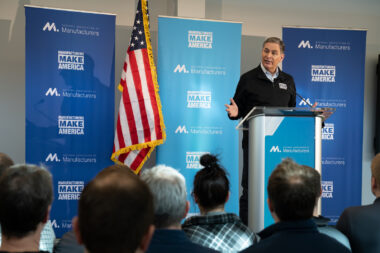
We’re hitting the road. This year’s NAM State of Manufacturing Address officially kicked off the 2023 leg of the NAM’s Competing to Win Tour. The tour will continue to spotlight the industry’s rapid transformation, while also focusing on manufacturing’s well-paying careers, diverse workforce and real-world solutions for the industry’s continued growth.
Upcoming stops: Waukesha and Pewaukee, Wisconsin (Tue, Feb 21); Fishers, Indiana (Wed, Feb 22); Harahan and Avery Island, Louisiana (Thurs, Feb 23)
